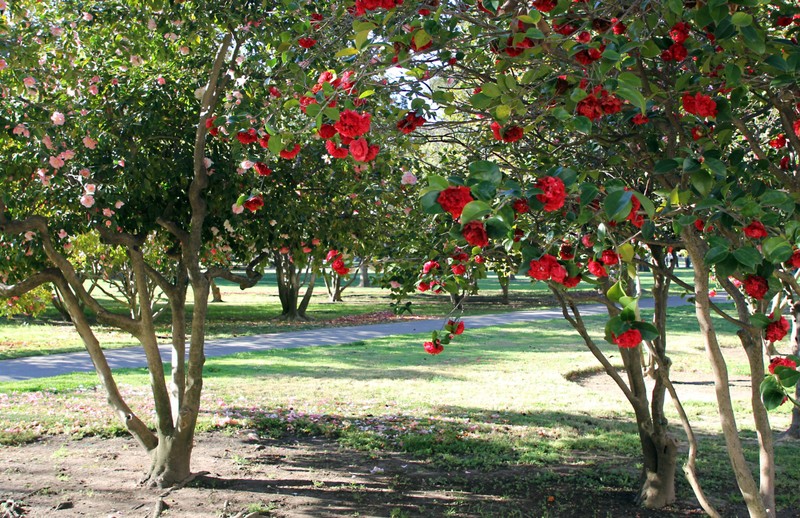New England Seed Store Historical Marker (Old Sacramento)
Introduction
Text-to-speech Audio
Dedicated in June 1989, this historical marker commemorates the former location of the New England Seed Store in Old Sacramento. Owned and operated by James L.L.F. Warren, the store became an important agricultural center amidst the California Gold Rush in the mid-1800s. The marker notes the significance of the camellia, a flowering plant that was first introduced to California by the store's owner, who brought the seeds with him from Boston. Originally cultivated in China over two thousand years ago, camellias now bloom profusely throughout Sacramento, where they have become a tradition in the capital city. Designated as the official flower of the city and county in 1961, the camellia is associated with the 19th-century pioneers who helped to shape the state of California.
Images
New England Seed Store Historical Marker (Old Sacramento)
.jpg)
The New England Seed Store became an important agricultural center in Old Sacramento amidst the California Gold Rush in the mid-1800s.
.jpg)
As noted on the marker, the camellia is the official flower of the city and county of Sacramento.
.jpg)
Camellias growing in Sacramento in Capitol Park

Backstory and Context
Text-to-speech Audio
In 1849, Colonel James L.L.F. Warren arrived in Old Sacramento from his home city of Boston to see if he could strike it rich during the California Gold Rush. When his attempts to find gold were largely unsuccessful, he decided to instead try his hand as a merchant. A commercial district had already begun to form near the confluence of the Sacramento and American Rivers, with merchants opening shops along the waterfront to sell groceries, clothing, tools, and other supplies to the thousands of miners arriving amidst the Gold Rush. In the early 1850s, James Warren established a business with a somewhat different focus, as he opened the New England Seed Store to provide agricultural supplies to the farming communities in the area.
Along with selling seeds that produced staple crops, Warren also imported from Boston various types of seeds for growing plants that had never yet been cultivated in California. Among these, he introduced camellias, which were originally cultivated in southeastern Asia more than two millennia ago. Camellia plants are flowering evergreen shrubs with thick foliage, lush blooms, and delicate petals that resemble those of a rose. While they are widely known for their ornamental beauty and gentle fragrance, Camellia sinensis plants have historically also been used for making tea. Following the introduction of camellias to California during the mid-1800s, these flowering shrubs took to the temperate climate and grew to become a tradition in Sacramento.
A century after James Warren brought the first camellia seeds with him from Boston, in 1953 a camellia grove was planted in Capitol Park adjacent to the Sacramento Capitol Building. Dedicated by the Sacramento County Parlors of the Sons and Daughters of the Native West, the grove includes a bronze plaque commemorating the site as "a living memorial to the early builders of California, in recognition of their courage, determination, and contribution toward progress in the community and our golden state." Several different types of camellias are featured along a paved pathway. Although the New England Seed Store is no longer standing in Old Sacramento, visitors to the capital city can enjoy these flowering plants, which became part of the Sacramento landscape in the mid-19th century. Named the official flower of the city and the county, camellias bloom almost year-round in Sacramento.
Sources
"Camellia Grove", California State Capitol Museum. Accessed June 21st, 2023. https://capitolmuseum.ca.gov/learn/about-the-capitol/capitol-park/camellia-grove/.
Gilmer, Maureen. Redwoods and Roses: The Gardening Heritage of California. Lanham, MD. Rowman & Littlefield, 2020.
"Warren's New England Seed Store", Anytime Tours. Accessed June 22nd, 2023. https://anytimetours.oncell.com/en/warrens-new-england-seed-store-188344.html.
Whittle, Syd. "New England Seed Store Historical Marker", Historical Marker Database. September 7th, 2008. Accessed June 21st, 2023. https://www.hmdb.org/m.asp?m=11193.
Syd Whittle / Hmdb
Syd Whittle / Hmdb
Syd Whittle / Hmdb
State of California Capitol Museum
